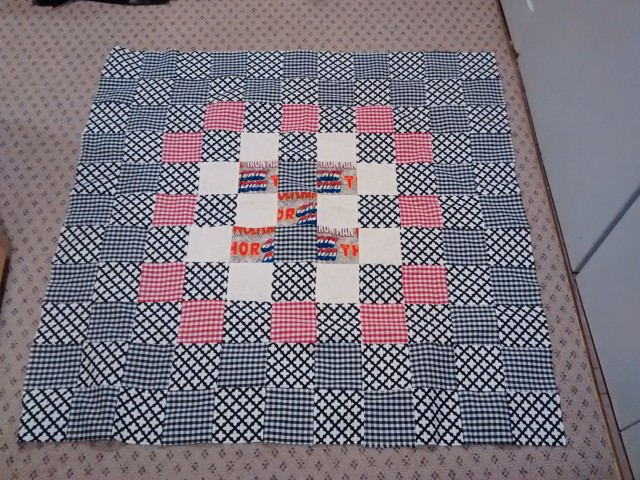Learning about patchwork and sewing
| sewingI’ve been looking into patchwork and quilting as a way to reuse scraps of fabric left over from sewing. That way, I don’t end up stashing stray odd-cuts forever, and I don’t feel guilty about trashing or donating material. (There are only so many zippered pouches I need in my life!) I can cut as many standard-size pieces as I can, and then store those in a more organized way.
I wanted to start pretty small: 4″x4″ squares (3.5″ after sewing with 1/4″ seam allowances), maybe 11×11 squares for a finished size of 38.5″ square. I still have lots of scraps to cut up, but I figured I’d give it a try first before committing the rest of my stash. Make a prototype, see what it’s like, maybe turn it into something for the cats or something to drape…
I counted the squares I cut from some fabric I had lying around, and assigned one-character labels for them. I stopped after I cut a little over 121 squares (11×11).
| A | red gingham | 12 |
| b | black gingham | 38 |
| m | marvel | 6 |
| D | beige | 11 |
| B | white crosses | 56 |
Time to plan! I created a dot grid (in Emacs, naturally) and began filling it in with characters, like so:
B.B.B.B.B.B ........... B.........B ........... B.........B ........... B.........B ........... B.........B ........... B.B.B.B.B.B
At first, I tried to keep track of the number of squares manually, but that got annoying to update as I tweaked the layout. By the time I got to something like this:
BbBbBbBbBbB bBbBbBbBbBb BbBABABABbB bBABDBDBABb BbBDmbmDBbB bBABDmDBABb BbBDmbmDBbB bBABDBDBABb BbBABABABbB bBbBbBbBbBb BbBbBbBbBbB
… I found this code to be really helpful for making sure I hadn’t put in more of one character than I had, and to show me which ones I still had left.
(let ((totals (mapcar (lambda (x) (cons (char-to-string (car x)) (length (cdr x)))) (-group-by 'identity (string-to-list (replace-regexp-in-string "\n" "" data)))))) (mapcar (lambda (x) (append (list (assoc-default (car x) totals) (- (elt x 2) (assoc-default (car x) totals))) x)) squares))
The first column has the number of squares used in the design. The second column has the number of squares left. The remaining columns were copied from the original table.
| 12 | 0 | A | red gingham | 12 |
| 38 | 0 | b | black gingham | 38 |
| 5 | 1 | m | marvel | 6 |
| 10 | 1 | D | beige | 11 |
| 56 | 0 | B | white crosses | 56 |
After lots of sewing and pressing, I ended up with something that looked reasonably like a patchwork quilt. It was actually pretty relaxing to sew once I got the hang of arranging things, since it just used straight lines. I unpicked two seams after stitching them incorrectly. The rest of the seams turned out okay.
In retrospect, maybe I shouldn’t have included two strong black-and-white prints. This one feels a little like an optical illusion, and it’s not that restful to look at it in full. I probably won’t be using it as a wall hanging, but it might be nice to use it to dress up one of the cat beds. I could skip the batting, buy a cotton or flannel sheet from the thrift store for use as backing, and then quilt it for practice. Skipping the batting this time around might let me get away without setting up a walking foot, too.
I still have tons to learn about dealing with colours and prints. Maybe I can learn faster with smaller blocks. I’ll probably cut more 4″ squares since that’s a convenient size for my grid ruler, and maybe 2.5″ or 2″ if there are leftover scraps that won’t fit. Then I’ll organize them by value and colour and see what I can make. I can turn them into shopping bags, since our current collection is starting to wear out. We’ll see how that goes!

